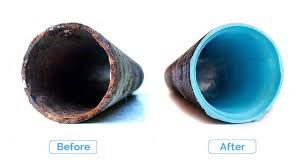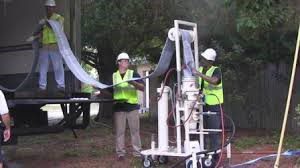Cure-In-Place Piping Benefits: A Greener Solution for Infrastructure
As cities and municipalities grapple with aging infrastructure, the need for sustainable solutions becomes increasingly important. Cure-In-Place Piping (CIPP) is a revolutionary method that provides significant environmental and economic benefits. This trenchless technology has gained popularity for reducing environmental disruption and material waste, making it a more sustainable solution for pipeline rehabilitation. In this article, we’ll explore the many benefits of Cure-In-Place Piping and how it contributes to greener infrastructure.

What is Cure-In-Place Piping (CIPP)?
CIPP is a trenchless method used to repair damaged pipelines by inserting a resin-saturated felt liner into the existing pipe. The liner is then cured in place using heat, water, or UV light, forming a seamless, jointless pipe within the existing infrastructure. Once cured, the newly formed pipe is strong and durable, restoring the pipeline’s structural integrity while eliminating the need for extensive excavation.
The materials used in CIPP play a critical role in its effectiveness and environmental benefits. Companies like Bouckaert Industrial Textiles (BIT) specialize in producing felt liners for CIPP applications. These liners are often made from a blend of fiberglass and polyethylene terephthalate (PET) fibers, which are known for their strength and durability. The blend of these materials not only improves the overall performance of the liner but also enhances the environmental benefits of the CIPP process. By providing a robust liner that, once impregnated with resin, creates a pipe with greater strength and longevity, BIT is helping ensure that CIPP repairs are built to last.

Environmental Benefits of CIPP
Reduced Excavation and Environmental Disruption
Traditional pipe replacement involves large-scale digging, which can devastate landscapes, disrupt local ecosystems, and contribute to soil displacement and waste. In urban areas, excavation also means tearing up roads, sidewalks, and other infrastructures, leading to increased material waste and environmental impact.
CIPP, however, eliminates the need for extensive digging. The repair happens from within the existing pipe, minimizing disruption to the surrounding environment. This not only helps preserve natural landscapes but also reduces the amount of waste material generated from excavation. In many cases, CIPP can be completed with only small access points, significantly reducing the project’s footprint on the environment.
Lower Carbon Footprint
The process of digging up and replacing pipes involves heavy machinery, increased transportation needs, and higher energy consumption. These factors collectively contribute to higher carbon emissions. Traditional pipeline replacement methods often require multiple machines to excavate, transport waste, and lay new pipes. This extended use of equipment increases fuel consumption and results in higher greenhouse gas emissions.
By avoiding these resource-intensive steps, CIPP projects can reduce their carbon footprint significantly. According to estimates, trenchless technologies like CIPP can lower carbon emissions by up to 85% compared to traditional methods. Research conducted by the Trenchless Technology Center (TTC) at Louisiana Tech University highlights the long-term environmental and cost-saving benefits of using trenchless methods for infrastructure repairs
The ability to complete a project without the need for large-scale machinery not only conserves fuel but also contributes to cleaner air by reducing emissions from construction vehicles.
Efficient Use of Materials
CIPP’s material efficiency is another factor that makes it an environmentally friendly option. Traditional methods require removing old pipes and replacing them with new ones, which generates significant waste and demands new raw materials like plastic, concrete, and steel. These materials have their own environmental costs, from extraction to manufacturing and transportation.
With CIPP, the existing pipe is retained, and the only materials needed are the resin and felt liner used to create the new pipe. By using the original pipeline as a mold, CIPP eliminates the waste associated with disposing of old pipes and minimizes the need for new materials. BIT’s use of fiberglass and PET blends for their felt liners provides an additional layer of sustainability. Fiberglass offers exceptional strength and temperature resistance, while PET, a recyclable plastic, ensures durability and contributes to a lighter environmental load. These materials are not only high-performance but also offer a longer-lasting solution, reducing the frequency of future repairs.
Water Conservation
Pipelines, especially older ones, are prone to leaks, leading to the loss of significant volumes of water over time. Water loss from leaky pipes is not only wasteful but also leads to increased energy use, as more water needs to be treated and pumped through the system to meet demand. CIPP addresses this issue by creating a watertight, seamless pipe that eliminates leaks and prevents further water loss.
By preventing leaks, CIPP helps conserve water and reduces the strain on water treatment facilities, which in turn conserves energy. The more efficient a pipeline system, the less energy is required to treat and distribute water, which contributes to lower carbon emissions overall.
Reduced Traffic and Energy Consumption
The shorter project duration of CIPP not only leads to less fuel consumption and lower emissions but also results in reduced traffic congestion. In many cities, pipeline repairs can cause road closures and traffic disruptions, forcing vehicles to idle in traffic or take longer routes, which increases fuel consumption. With CIPP, the need for road closures and extended construction timelines is minimized, leading to less disruption for commuters and lower overall energy use during the project.
Longevity and Durability of CIPP Repairs
One of the most significant environmental benefits of CIPP is the longevity of the repairs it provides. Once cured, the newly formed pipe is resistant to corrosion, cracking, and root intrusion, all of which are common issues in older pipelines. The durability of CIPP repairs reduces the need for future interventions, meaning fewer resources are needed to maintain the pipeline over time. Many CIPP installations can last for 50 years or more, making it a long-term solution that minimizes the frequency of repairs and the associated environmental costs.
By using fiberglass/PET blends for their felt liners, BIT enhances the strength of CIPP installations. This increased strength ensures that pipelines can withstand greater pressure and environmental stresses, further extending their lifespan and reducing the need for repairs. The combination of fiberglass and PET offers superior tensile strength, making it ideal for high-stress applications where durability is essential.
Protecting Ecosystems and Reducing Pollution
Traditional pipe replacement can result in the release of dust, debris, and potentially harmful materials into the environment. In some cases, excavating pipelines near waterways can introduce contaminants into the water supply, threatening local ecosystems. CIPP minimizes these risks by containing the repair process within the existing pipe, reducing the potential for pollutants to enter the environment.
Additionally, because CIPP does not require extensive excavation, it avoids disturbing nearby ecosystems. Whether the pipeline runs through a forested area or under a city street, the trenchless nature of CIPP ensures that the surrounding environment is preserved during the repair process.
Conclusion
As the world shifts toward more sustainable practices, Cure-In-Place Piping offers a greener, more efficient solution for pipeline rehabilitation. Its ability to reduce environmental disruption, lower carbon emissions, conserve water, and extend the life of pipelines makes it an environmentally responsible choice for infrastructure projects. By leveraging cutting-edge materials like BIT’s fiberglass and PET blends, CIPP installations provide enhanced durability and long-term performance, ensuring that repairs are both sustainable and built to last.
Bouckaert Industrial Textiles plays a key role in advancing these green initiatives by supplying high-quality felt liners that contribute to the environmental benefits of CIPP. As more cities and industries embrace trenchless technology, CIPP will continue to be a vital tool in the effort to create greener, more resilient infrastructure.

